
The Schempp-Hirth Nimbus-4 is a family of high-performance FAI Open Class gliders designed by Klaus Holighaus and manufactured by Schempp-Hirth Flugzeugbau GmbH in Kirchheim, Germany. The Nimbus-4 first flew in 1990.
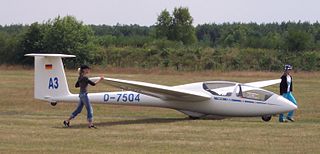
The ASK 21 is a glass-reinforced plastic (GRP) two-seat glider aircraft with a T-tail. The ASK 21 is designed primarily for beginner instruction, but is also suitable for cross-country flying and aerobatic instruction.
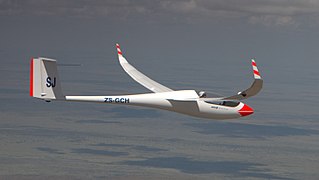
|} The Jonker JS-1 Revelation is a glider built of glass-fibre, carbon fibre and Kevlar. It is available with an 18-metre span for the 18 metre class or a 21-metre span for the Open class. The manufacturer is Jonker Sailplanes of PotchefstroomSouth Africa, founded in 2004 by two brothers, Attie and Uys Jonker. The structural and chief designer is Attie Jonker, while the airfoil and main aerodynamic features were developed by Johan Bosman in co-operation with the Delft University of Technology.

The Silent 2 Targa is a single seater sailplane of Italian manufacture. It is of the FAI DU Class glider. It is sold by Alisport ready-to-fly or kit-built as pure glider or self-launching glider. The self-launching version can be fitted with a single-blade propeller belt-driven by a two-stroke engine or with a double-blade folding propeller directly driven by an electric motor.

The Silent Club is a single seater sailplane of Italian manufacture. It is of the FAI type DU Class glider. It is sold by Alisport ready-to-fly or kit-built as pure glider or self-launching glider. The self-launching version is fitted with a single-blade propeller belt-driven by a two-stroke engine or optionally by an electric motor.
The FVA 1 Schwatze Düvel was a glider produced in Germany in 1920. It was a highly streamlined, thick winged cantilever monoplane.

A glider or sailplane is a type of glider aircraft used in the leisure activity and sport of gliding. This unpowered aircraft can use naturally occurring currents of rising air in the atmosphere to gain altitude. Sailplanes are aerodynamically streamlined and so can fly a significant distance forward for a small decrease in altitude.

The Slingsby T.43 Skylark 3 was a single seat Open Class sailplane developed from the Skylark 2 with an extended wingspan. It won the 1960 World Gliding Championships.
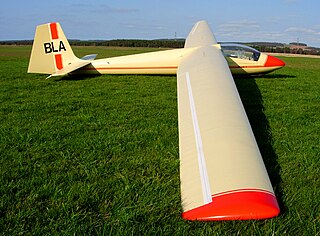
The Slingsby T.50 Skylark 4 was a British single seat competition glider built by Slingsby Sailplanes in the early 1960s. It sold in numbers and had success at national, though not world level competition.

The Maupin Carbon Dragon is an American, high-wing, single-seat, glider that was designed by Jim Maupin and made available as plans for amateur construction. Plans are no longer available.
The Dart Cambridge was a single-seat competition sailplane built in the United Kingdom in the 1930s. A development of the Grunau Baby, only two were built, flying with gliding clubs.
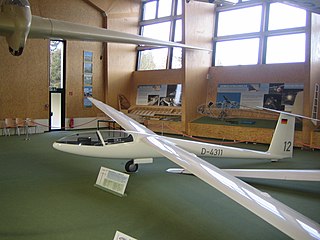
The Akaflieg Darmstadt D-36 Circe is a single seat, high performance sailplane designed and built in Germany in the mid-1960s, one of the early "glass ships". It was the winner at the German National Championships in 1964 and came second in the World Championships the following year.

The Cijan-Obad Orao is a competition single seat sailplane designed in Yugoslavia just after World War II, one of the most advanced of its type at the time. It flew in three World Gliding Championships, having greatest success at its first in 1950 when it reached third place.
The CVV 2 Asiago is a simple, single seat glider designed and built in Italy in the mid-1930s, the second of a series of gliders from the Milan Polytechnic and the first go into production.

The Alisport Silent 2 Electro is an Italian mid-wing, single-seat motor glider, designed and produced by Alisport of Cremella and provided as a complete ready-to-fly aircraft. The aircraft was introduced at the Aero show held in Friedrichshafen in 2011.
The Aviomilano CPV1, also known as the Arlecchino, was an Italian high performance sailplane built in the early 1960s. Only one was built.
The CVT1 Zigilo was a single-seat, 12-metre-span (39 ft) Italian training glider designed and built in Italy in the 1950s. Only one was completed.

The Scheibe Specht is a tandem seat training glider produced in Germany in the early 1950s. More than fifty were built.
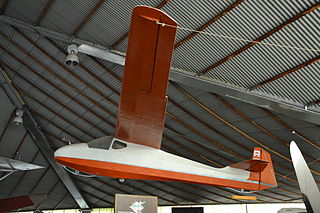
The Schneider ES-57 Kingfisher is a low-cost, short-span Australian glider capable of respectable cross country soaring flights. It was produced in small numbers in the late 1950s.
The PZL M-3 Pliszka (Wagtail) was the first all-metal Polish glider. Three were built but its performance, particularly its glide ratio, was not good enough for it to be produced for Polish clubs.















